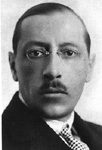Twentieth Century: Important Composers, Theorists, and Performers
Igor Stravinsky (1882-1971)

Igor Stravinsky's (1882-1971) compositional evolution is incomparable to any other composer’s work. He wrote in a very diverse number of styles, yet still maintained that which was Stravinsky. He, like many other composers, was encouraged to study law by his family. While he was studying at the University of St. Petersburg in Russia, he met Nicolai Rimsky-Korsakov, and began to study with him. Rimsky-Korsakov was an incredible pianist and composer whose talent was widely known. Stravinsky was soon commissioned to write the music for many ballets in Paris including "The Firebird," "Petrushka," and "The Rite of Spring" which were all very successful. He eventually migrated to the United States, where he attempted to write music for film, but was unsuccessful. Stravinsky continued to write for many years, but nothing became quite as well known as his earlier ballets.
Stravinsky’s early music showed the influence of his Russian origins. By the time he was writing for ballets in Paris, he was using a new concept of polytonality where more than one tonal/key center is being played at the same time; for example the key of C Major played against the key of E Major. While many might think polytonality has a very dissonant or harsh sound, when used by Stravinsky it has a very dramatic effect. Later in his life he utilized the new methods of twelve-tone and serial composition.
![]() Listen to the example below:
Listen to the example below: